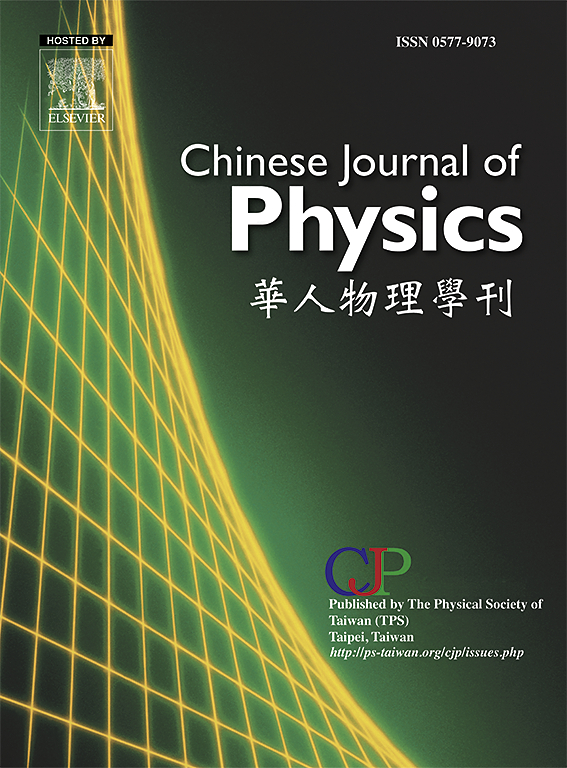Probing the two-electron-interaction-induced three new hopping processes in a double quantum-dot system revealed by finite-frequency shot noise
IF 4.6
2区 物理与天体物理
Q1 PHYSICS, MULTIDISCIPLINARY
引用次数: 0
Abstract
In the serially coupled double quantum dot (DQD) system, the two-electron-interaction-induced electron hopping processes and spin-exchange hopping processes play a crucial role in manipulating the spin degree of freedom of localized electrons in the DQD system. Consequently, from the perspective of electron transport, how to detect the new hopping processes induced by the two-electron interaction has become an increasingly important issue. Here, the influences of the three new hopping processes predicted by the generalized Hubbard model on the finite-frequency shot noise of electron transport through a serially coupled DQD system are studied. It is demonstrated that in the energy-level detuning case the criterion for the existence of the electron-occupation-modulated hopping processes is that the maximum number of peaks and dips of the finite-frequency shot noise equals eight while in the energy-level alignment case the criteria for the existence of the two-electron-interaction-induced three new hopping processes, and the antiparallel-electron-spin-exchange hopping and electron-pair hopping processes, and the electron-occupation-modulated hopping processes are that the maximum numbers of peaks and dips equal eight, seven, and six, respectively. Therefore, these results provide an alternative way to detect the three new hopping processes predicted by the generalized Hubbard model in the serially coupled DQD system.

探测有限频射噪声揭示的双量子点系统中双电子相互作用诱导的三个新跳跃过程
在串联耦合双量子点(DQD)体系中,双电子相互作用诱导的电子跳变过程和自旋交换跳变过程在操纵DQD体系中局域电子的自旋自由度方面起着至关重要的作用。因此,从电子传输的角度来看,如何探测双电子相互作用诱导的新跳变过程已成为一个越来越重要的问题。本文研究了广义哈伯德模型预测的三种新跳变过程对电子通过串联耦合 DQD 系统传输的有限频率射出噪声的影响。结果表明,在能级失谐情况下,电子占位调制跳变过程存在的标准是有限频率射出噪声的最大峰值和骤降数等于 8,而在能级对齐情况下,双电子相互作用诱导的三个新跳变过程存在的标准是:电子占位调制跳变过程的最大峰值和骤降数等于 8,而在能级对齐情况下,双电子相互作用诱导的三个新跳变过程存在的标准是:电子占位调制跳变过程的最大峰值和骤降数等于 8、和反平行电子自旋交换跳变过程、电子对跳变过程以及电子占位调制跳变过程存在的标准是峰值和骤降的最大数量分别等于 8、7 和 6。因此,这些结果为探测串联耦合 DQD 系统中广义哈伯德模型预测的三种新的跳变过程提供了另一种方法。
本文章由计算机程序翻译,如有差异,请以英文原文为准。
求助全文
约1分钟内获得全文
求助全文
来源期刊

Chinese Journal of Physics
物理-物理:综合
CiteScore
8.50
自引率
10.00%
发文量
361
审稿时长
44 days
期刊介绍:
The Chinese Journal of Physics publishes important advances in various branches in physics, including statistical and biophysical physics, condensed matter physics, atomic/molecular physics, optics, particle physics and nuclear physics.
The editors welcome manuscripts on:
-General Physics: Statistical and Quantum Mechanics, etc.-
Gravitation and Astrophysics-
Elementary Particles and Fields-
Nuclear Physics-
Atomic, Molecular, and Optical Physics-
Quantum Information and Quantum Computation-
Fluid Dynamics, Nonlinear Dynamics, Chaos, and Complex Networks-
Plasma and Beam Physics-
Condensed Matter: Structure, etc.-
Condensed Matter: Electronic Properties, etc.-
Polymer, Soft Matter, Biological, and Interdisciplinary Physics.
CJP publishes regular research papers, feature articles and review papers.
 求助内容:
求助内容: 应助结果提醒方式:
应助结果提醒方式:


